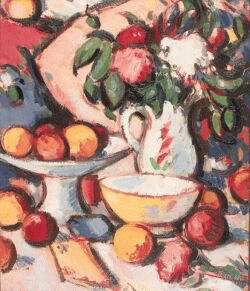
Lot 135

JOHN DUNCAN FERGUSSON R.B.A (1874-1961) §
THE YELLOW BOWL


Auction: 8 December 2000 at 11:00 GMT
Description
Signed and dated 1911 on the reverse, oil on board,
61cm(24in) x 51cm(20in)
Sold for £108,000
Footnote
Exhibited:Internationale Kunst Austellung des Sonderbundes, Cologne, 1912 priced at 1200 marks
Note:The re-emergence of J.D.Fergusson's The Yellow Bowl as an important example of his fully developed style adds greatly to the small number of mature still lives exemplified by La Bete Violette. Painted in Paris in 1911 at the height of his powers the current work demonstrates the transition of Fergusson's early work, with it's references to Velasquez and Manet to the bold and innovative technique which mark him out as a leading artist of the avant-garde.
The years 1910-12 were particularily important for Fergusson as he immersed himself in Parisian cultural life. Appointed Art Editor of the radical art journal Rhythm, Fergusson commissioned work from artists such as Derain, De Segonzac, Othon-Friesz, Gaudier-Brzeska and Picasso as well es exhibiting at the Slaon d'Automne with Matisse, Metzinger and Chabaud.In 1912 Fergusson organised a display of the Rhythmists work in Cologne at the international Kunstausstellung des Sonderbundes. The Yellow Bowl from 1911 was one of his exhibits.
Stylistically The Yellow Bowl bridges the gap between two seminal still lives, La Bete Violette of 1910 and The Blue Vase of 1912 now in the City Art Centre. All three paintings make use of familiar objects from Fergusson's studio notably the tazza-like fruit comport, the floral jug and the yellow bowl which gives the current picture it's title. Arranged in a complex pattern of shapes and forms united by his use of colour, Fergusson's best work, as a contemporary critic Huntly Carter commented, served 'not merely to illustrate the soul of the subject matter, but to lift the spectator out of himself'.

